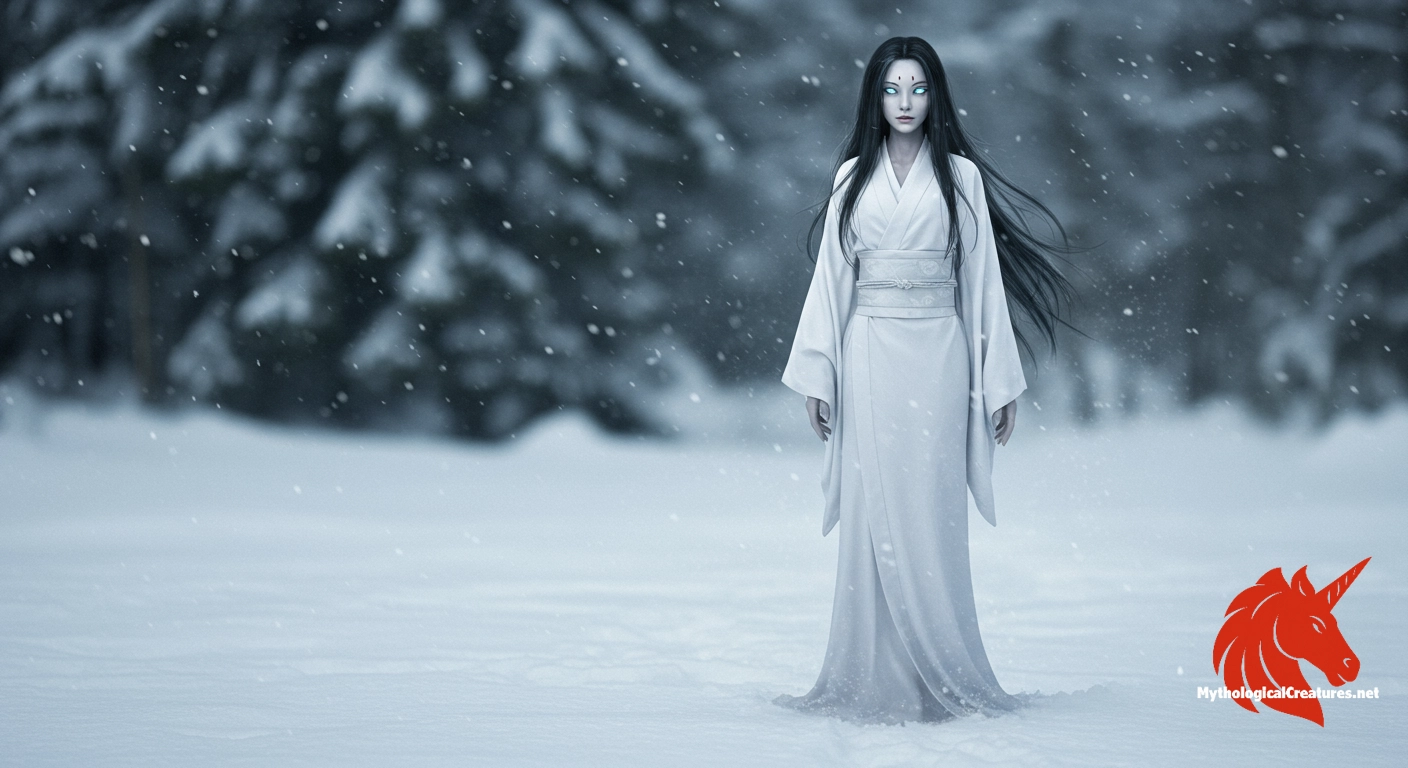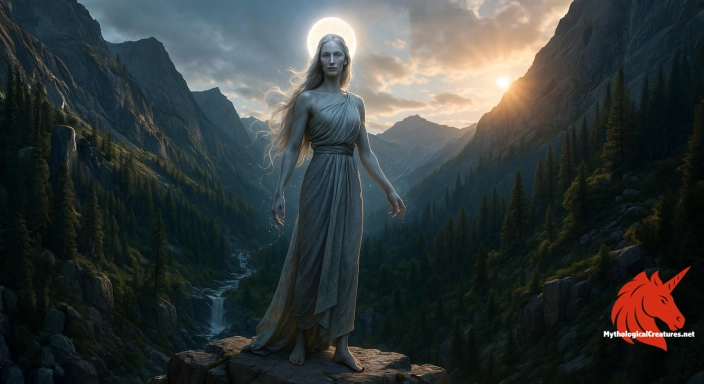Yuki-onna: Yuki-onna is a spectral, beautiful snow woman from Japanese folklore known for her icy aura and enigmatic charm.

Yuki-onna
Yuki-onna - Represents the captivating yet perilous nature of winter, symbolising both life and death.
Origins & First Encounters
Yuki-onna, the enigmatic snow woman, has long captivated the imaginations of those who wander through Japan’s wintry landscapes. Born from the cold austerity of harsh winters, her origins blend the delicate beauty and lethal dangers of snowbound nights into one ethereal figure. Emerging in folklore during the Edo period and likely rooted in even older mythic traditions, she has been an enduring presence in the collective consciousness. Her lore vividly captures the duality of winter, where the serene, almost otherworldly allure of pristine snow masks its hidden perils. Often depicted as a graceful yet formidable spectre, she both seduces and terrifies those she encounters on lonely, frost-bitten paths. Her spectral beauty is matched by an air of melancholy that mirrors the transient, ephemeral nature of life itself. Over the centuries, the legend of Yuki-onna has been interwoven with moral and supernatural lessons that warn against the unpredictability of nature. As such, she remains a symbol of both the life-affirming and destructive facets of winter. Her myth continues to thrive in literary and artistic circles, echoing the age-old interplay between beauty, isolation, and mortality. Modern reflections on her tale invite audiences to question the boundaries between nature’s majesty and its merciless cruelty.
Source Texts & Tale Variants
Early folk narratives and classical texts have cemented Yuki-onna’s place as a central figure in Japanese supernatural lore. Diverse collections of ghost stories from the Edo period recount her as a figure capable of both compassion and cold-hearted retribution. Oral traditions across the countryside have enriched her myth, presenting her in multifarious guises that range from a benevolent guardian to a perilous seductress. In several written accounts, travellers recount eerie encounters on wintry nights, where a mysterious figure in white leads them to either salvation or doom. Manuscripts and ghost anthologies, passed down through generations, capture the ambiguity of her nature, highlighting her potential for both grace and terror. Some texts narrate her origins as stemming from tragic love or unfulfilled desires, thereby lending her character an undercurrent of sorrow. Periodic reinterpretations in literature have continuously added layers to her persona, enabling her to reflect shifting cultural moods. The flexibility of these narratives has allowed Yuki-onna to adapt her form and motivations, making each regional account distinctly memorable. The variety of story variants underscores the enduring appeal of her myth and its capacity to embody the complexities of human emotion intertwined with natural forces. Her presence in these historical sources continues to inspire new adaptations as storytellers explore the realms of both horror and romance.
Form & Powers
Yuki-onna is most often portrayed as an exquisitely beautiful woman whose appearance mirrors the pristine, deceptive brilliance of freshly fallen snow. Her skin is described as translucent and pale, emitting a soft luminescence that seems to capture the very essence of winter’s chill. Draped in a flowing white kimono, she exudes an aura of serene elegance that belies the deadly cold latent within her. The delicate features of her face, marked by an enigmatic calmness and luminous eyes, create an impression of both innocence and inscrutable sorrow. In some depictions, her flowing hair contrasts dramatically with her icy complexion, either cascading darkly or shimmering like spun silver under moonlight. There is often an almost imperceptible smile playing on her lips—a subtle hint at the tragic beauty hidden beneath her spectral presence. Observers have noted that her form sometimes appears to merge with the drifting mists or falling snow, as if she is a natural extension of the winter storm. Such visual details contribute to her portrayal as simultaneously ephemeral and unforgettable. The interplay of light and shadow in her features suggests an ineffable connection with the natural world, where beauty and danger coexist. Overall, her physical presence remains a compelling blend of fragile allure and formidable supernatural power.
Regional Faces
Across Japan, the portrayal of Yuki-onna adapts vividly to local customs and environmental narratives. In regions like Nagano, she is sometimes known by names such as “yukifuri-baba,” which imbue her with the gravitas of age and the raw force of winter’s fury. In the Ehime prefecture and other areas, variants like “yuki-onba” further underscore her role as both an alluring and cautionary figure, blending youthful charm with the inevitability of decay. Rural communities often see her as an embodiment of nature’s caprice, a dual force capable of both nurturing and devastating the land during icy spells. The specifics of her encounters with mortals can differ markedly from one district to another, tailored by local climate and cultural memory. In some local legends, she appears as a benign spirit guiding lost travellers through treacherous snowstorms, while in others, she is a fearsome omen heralding disaster. These regional narratives are often infused with a sense of moral ambiguity, where her actions serve as both punishment and a mysterious form of protection. Despite these variations, the core motif of her being an irresistible, otherworldly entity of winter prevails. The diversity of her names and stories reflects not only the linguistic richness of Japan’s cultural landscape but also the universal human response to nature’s wintery trials. Such adaptations ensure that Yuki-onna remains a dynamic and ever-relevant myth, continuously moulded by the distinct ethos of each locale.
Cultural Parallels
The legend of Yuki-onna finds interesting parallels in various mythological traditions around the world, particularly those that explore the enigmatic qualities of winter. Similar to European ice queens and frost witches, her image merges allure with peril, symbolising the delicate balance between beauty and the inherent dangers of cold. In Celtic mythology, otherworldly figures often embody the capricious nature of winter and share the fatal attraction that characterises Yuki-onna. Her role as a mysterious seductress, capable of luring travellers into dangerous environments, resonates with archetypes like the siren, whose enchanting appearance masks lethal intentions. Even within Japanese folklore, her qualities echo those of other yōkai, whose dual characteristics blur the boundaries between benevolence and malevolence. This cross-cultural pattern underscores a universal fascination with the personification of nature’s most treacherous elements, where beauty is inextricably linked with risk. Much like the renowned Snow Queen from European fairytales, Yuki-onna embodies the complexity of winter—not merely as a season but as a force that both captivates and imperils. Her myth also invites comparisons with figures such as the Slavic frost spirit and even the melancholic portrayals found in modern reinterpretations of legendary beings. These cultural parallels highlight the shared human experience of confronting nature’s sublime yet formidable power. Ultimately, such comparative insights enrich the interpretation of Yuki-onna’s legend, revealing the common motifs that traverse diverse mythological landscapes.
Legacy & Modern Evolution
The portrayal of Yuki-onna has evolved dramatically over centuries, mirroring shifts in cultural attitudes toward nature and the supernatural. Initially conceived as a terrifying force of nature whose icy touch foretold death, early depictions were stark and unyielding in their portrayal of winter’s cruelty. In time, however, artistic and literary reinterpretations began to lend her a more nuanced character, intertwining elements of sorrow, longing, and even redemption. Modern portrayals in anime, manga, and cinema often reimagine her as both a tragic figure and a symbol of the ephemeral beauty of existence. Contemporary artists have sought to humanise her, exploring themes of isolation, loss, and the bittersweet passage of time that resonate in today’s urban and digital landscapes. Her image has become a versatile motif that encapsulates the inherent tensions between nature’s serene beauty and its unforgiving aspects. The continual reinvention of her story reflects a broader trend in mythology where ancient folklore is reinterpreted for modern sensibilities. Exhibitions, literature, and even digital media consistently draw upon her enduring charm to comment on contemporary issues of alienation and environmental fragility. In adapting this centuries-old myth, creators highlight a timeless dialogue between the allure of the past and the challenges of the modern era. Yuki-onna remains a potent reminder of the enduring power of myth and its ability to evolve alongside cultural and societal transformations.
Interesting Fact
In certain regional variations, Yuki-onna is depicted as part of a lineage of snow apparitions, each with its own unique lore and tragic narrative.
Quick Creature Info
Features:
Associations:
Our Mythic Legendary Rating:

Also Sometimes Known As:
Habitat:
Supernatural Powers:
Physical Attributes:
Abilities:
Behavior:
Weaknesses:
Lore:
References
Discover Another Mythical Legend You May Not Have Heard Of?
Uncover the mysteries of ancient folklore and expand your knowledge of legendary beings from cultures around the world.
Dare to Meet the E Bija e Hënës dhe e Diellit....
Mythical Disclaimer: The images and data on this site are derived from various historical and literary sources, but we have found that many myths often have multiple versions and interpretations across references, sometimes contradictory. As a result, these creature depictions are artistic interpretations—imaginative blends of folklore, legend, and a dash of AI guesswork. Because creature descriptions vary widely, our illustrations and accompanying information represent our best effort to honor mythology while bridging creative gaps. Enjoy these interpretations—just remember, we've done our best to respect the stories and validate available data, but in the realm of mythology, details often shift, imagination leads the way, and nothing is ever set in stone!
Curated by the Mythological Creatures Team (rev. May 2025)
